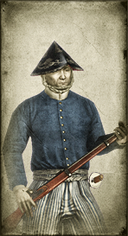
Basic Unit Statistics (can be modified by difficulty level, arts, skills, traits and retainers)
| Recruitment Cost | 500 | |
| Upkeep Cost | 80 | |
| Melee Attack | 3 | 8% |
| Charge Bonus | 8 | 16% |
| Bonus vs Cavalry | 2 | 6% |
| Range | 125 | 19% |
| Accuracy | 10 | 10% |
| Reloading Skill | 5 | 5% |
| Ammunition | 15 | 18% |
| Melee Defence | 1 | 2% |
| Armour | 1 | 6% |
| Morale | 4 | 8% |
Strengths & Weaknesses
- Poor accuracy and slow reload rate.
- Weak in melee.
- Weak against cavalry.
- Average morale.
Requires
Description
To defend one's home is an act of a brave and worthy man.
Levy infantry are raised as militia: second-line forces that are trained to a reasonable standard but are not full time or professional soldiers by any means. They are a strategic defensive force, acting as garrisons and guards in their home provinces. On the battlefield, they can give a good account of themselves, and can use their smoothbore guns efficiently. However, these weapons are slow to load and, because they are not rifled, they are not particularly accurate or long-ranged. They are, however, simple, rugged, dependable and cheap. Levies have surprisingly decent morale, but they are not well-suited to close combat, and they will take casualties if cavalry are allowed to overrun them. These militia troops were the natural successors to the ashigaru of earlier Japanese history. The ashigaru were men of the peasant class, rather than samurai warriors, who made a living as soldiers. Although equipped, armed and drilled in European style, often by European mercenary officers and sergeants, the levies retained the distinctive jingasa helmets of the ashigaru. This conical helmet was actually a more practical bit of kit than a European hat. There was a chance, for a start, that it might keep out a shell splinter; it was waterproof; and it could, at a pinch, be turned upside down and used as a cooking pot.